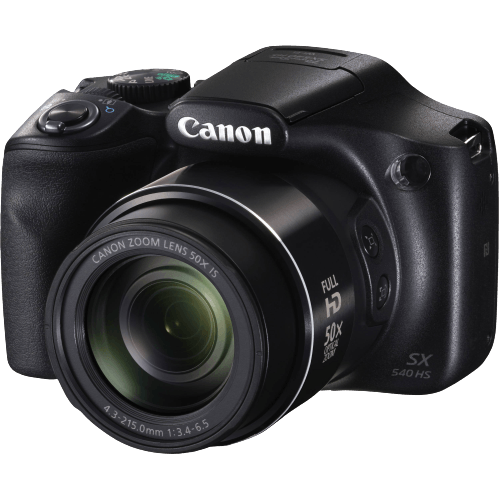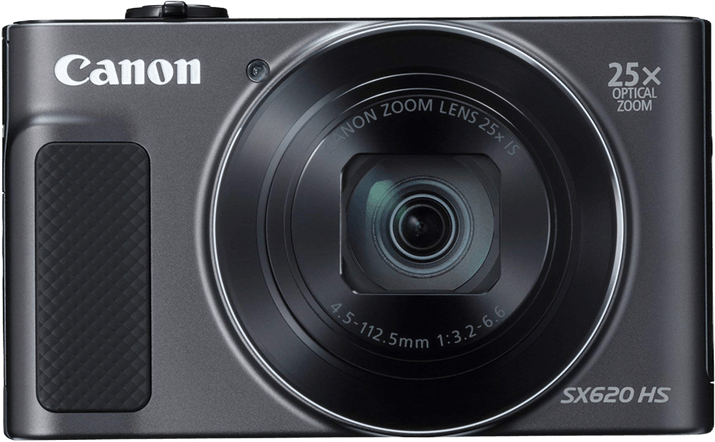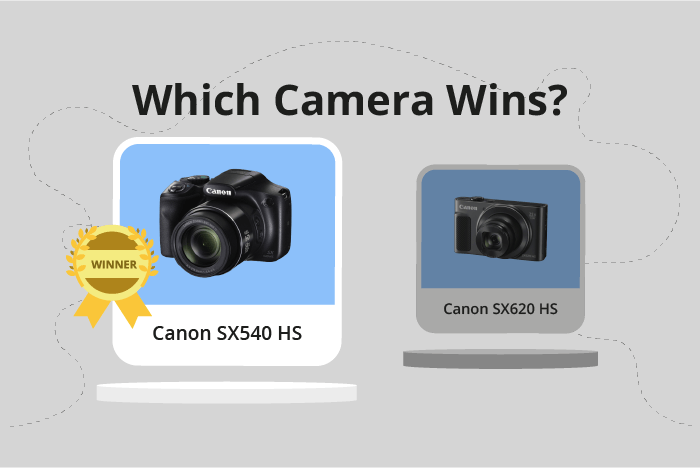Canon PowerShot SX540 HS vs PowerShot SX620 HS Comparison
Canon PowerShot SX540 HS

Canon PowerShot SX620 HS

The Canon PowerShot SX540 HS takes the lead with a score of 52/100, while the Canon PowerShot SX620 HS follows closely with a score of 49/100. Both cameras share some common specifications, such as their announcement in 2016 and being part of the Canon PowerShot series.
The SX540 HS stands out due to its bridge camera type, larger size (120 x 82 x 92mm), and heavier weight (442g). These features contribute to its higher score and make it a more robust and versatile camera.
On the other hand, the SX620 HS is a compact camera with a smaller size (97 x 57 x 28mm) and lighter weight (182g). These characteristics make it more portable and convenient for casual photography.
Taking these points into consideration, the Canon PowerShot SX540 HS is a better camera for those seeking versatility and robustness, while the Canon PowerShot SX620 HS is a more suitable option for those prioritizing portability and convenience.
Canon PowerShot SX540 HS vs PowerShot SX620 HS Overview and Optics
The Canon PowerShot SX620 HS wins in the optics comparison with a score of 54/100, while the Canon PowerShot SX540 HS scores 51/100. Both cameras possess similar specifications, including 20 megapixels, CMOS sensors, fixed lens mounts, and image stabilization. Their sensor sizes are also identical at 1/2.3″.
The SX620 HS outperforms the SX540 HS in terms of its processor and DXOMARK sensor score. The SX620 HS is equipped with a Digic 4+ processor and has a DXOMARK sensor score of 65, which contributes to better image quality and processing capabilities. This gives the SX620 HS an edge over the SX540 HS, which has a DIGIC 6 processor and a DXOMARK sensor score of 47.
However, the SX540 HS has a higher shooting speed of 5.9 compared to the SX620 HS’s shooting speed of 2.5. This means that the SX540 HS can capture images more quickly, making it suitable for fast-paced photography situations.
Considering these points, the Canon PowerShot SX620 HS offers better image quality and processing abilities due to its higher DXOMARK sensor score and superior processor. On the other hand, the Canon PowerShot SX540 HS provides faster shooting speeds for capturing action shots. Both cameras have their own strengths, and the choice between them depends on the specific needs and preferences of the user.
Canon PowerShot SX540 HS vs PowerShot SX620 HS Video Performance
The Canon PowerShot SX540 HS outperforms the Canon PowerShot SX620 HS in video capabilities, earning a score of 56/100 compared to the latter’s 43/100. Both cameras share some common specifications, such as Full HD video resolution with maximum dimensions of 1920 x 1080, and neither has built-in time-lapse functionality.
The SX540 HS excels due to its higher maximum video frame rate of 60fps, which is double the SX620 HS’s 30fps. This higher frame rate allows for smoother video playback and improved slow-motion capabilities, making it ideal for capturing fast-paced action or sports events.
The SX620 HS, on the other hand, does not excel in video capabilities compared to the SX540 HS. Its lower video score and maximum frame rate of 30fps limit its potential for capturing high-quality video. As a result, it may not be the best option for those who prioritize video performance in their camera selection.
In comparing the Canon PowerShot SX540 HS and SX620 HS, it is clear that the SX540 HS has superior video capabilities due to its higher score and greater maximum video frame rate. While both cameras share some common specifications, the SX540 HS’s performance makes it the better choice for users who prioritize video quality and performance. The SX620 HS may still be suitable for casual video recording, but it falls short in comparison to the SX540 HS.
Canon PowerShot SX540 HS vs PowerShot SX620 HS Features and Benefits
The Canon PowerShot SX540 HS emerges as the winner in this comparison with a feature score of 64/100, while the Canon PowerShot SX620 HS trails behind with a score of 41/100. Both cameras share several specifications, such as a 3-inch screen size, flip screen, absence of GPS, and Wi-Fi capabilities.
The SX540 HS outperforms the SX620 HS with its touchscreen functionality and Bluetooth connectivity. The touchscreen allows for more intuitive control, making it easier to navigate menus, review images, and adjust settings quickly. The addition of Bluetooth further enhances the camera’s connectivity capabilities, enabling seamless pairing with compatible devices for quick photo sharing and remote control options.
On the other hand, the SX620 HS has a higher screen resolution at 922,000 dots compared to the SX540 HS’s 461,000 dots. This higher resolution provides clearer and more detailed image previews, which can be helpful when reviewing shots for focus and composition accuracy.
Despite the SX620 HS’s advantage in screen resolution, the SX540 HS remains the superior camera due to its higher overall feature score. The touchscreen and Bluetooth capabilities give it an edge in usability and connectivity, making it a more versatile and convenient option for users.
In evaluating these cameras, it is evident that the Canon PowerShot SX540 HS offers more advanced features and better overall performance. The SX620 HS does have a higher screen resolution, but this advantage is outweighed by the SX540 HS’s touchscreen and Bluetooth functionalities. Therefore, the Canon PowerShot SX540 HS stands as the better choice between the two cameras.
Canon PowerShot SX540 HS vs PowerShot SX620 HS Storage and Battery
The Canon PowerShot SX620 HS outperforms the Canon PowerShot SX540 HS in storage and battery with a score of 29/100 compared to 13/100. Both cameras have one memory card slot and accept SD, SDHC, and SDXC cards.
The SX620 HS has a longer battery life of 295 shots, while the SX540 HS lasts for 205 shots. The SX620 HS also has the advantage of USB charging, making it more convenient to recharge the battery. The SX540 HS lacks this feature and relies on its NB-6LH battery type.
On the other hand, the SX540 HS does not have any particular advantage over the SX620 HS in terms of storage and battery. Therefore, the SX620 HS is the clear winner in this category, offering longer battery life and the added convenience of USB charging.
Canon PowerShot SX540 HS vs PowerShot SX620 HS – Our Verdict
Are you still undecided about which camera is right for you? Have a look at these popular comparisons that feature the Canon PowerShot SX540 HS or the Canon PowerShot SX620 HS:
- Canon PowerShot SX540 HS vs Nikon Coolpix B500
- Canon EOS Rebel T7 / 2000D vs PowerShot SX540 HS
- Canon PowerShot SX540 HS vs PowerShot SX70 HS
- Canon PowerShot SX540 HS vs Panasonic DC-ZS70 / DC-TZ90
- Canon PowerShot SX540 HS vs Panasonic Lumix FZ80 / FZ82
- Canon PowerShot SX540 HS vs Panasonic Lumix ZS80

